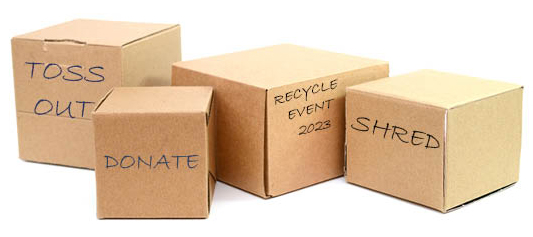Should It Stay or Should It Go? Making Peace with Our Stuff

The popularity of books such as The Gentle Art of Swedish Death Cleaning by Margareta Magnusson and Gretchen Rubin’s Outer Order Inner Calm: declutter and organize to make more room for happiness have many of us taking a deeper look at our possessions, buying habits, and living environments—even our technology (digital) clutter.
Magnusson’s process uses the Swedish method of Döstädning. Translation: “death cleaning.” This approach helps you put your belongings and affairs in order so your loved ones won’t have to do so after you pass. Rubin’s mantra is to first get rid of everything you don’t need, use, or love. And who doesn’t want to “make room for happiness?” Both use humor and offer practical advice.
Truth is, three out of five of adults over age 60 feel they have more stuff than they need. And yet, many of us find it emotionally painful to cull our belongings. Decluttering, downsizing, or “rightsizing” takes on a particular urgency if we anticipate a move. It can be anxiety-provoking. The challenge might even cause you to ignore or delay the issue all together.
Don’t fret! There’s hope. With a few simple steps you can begin to make peace with your “stuff.” If you apply these steps, I promise you will come out the other end of the process feeling accomplished, more clear-minded, and happier.
Be prepared, however, for the emotions that come with possessions. We have all experienced this. The process of deciding what to keep, what to donate, and what to throw away are filled with decisions that are not made lightly. Emotions are often triggered by something as simple as a book, a knick-knack, a letter, an outdated piece of clothing, a photograph. You hold the item in your hands and suddenly the memories tied to that possession take over.
Where do you begin? Most of us have lived in our homes for years. This makes the accumulation of things and memories more likely. There are many reasons we hold on to things: sentimental attachments, perceived or real value; being overwhelmed; feelings of self-worth; and identity. So, you begin by acknowledging this reality and the associated emotions. Our clutter can also serve as a distraction from deeper issues we are avoiding and as a buffer from pain.
Acknowledge the emotions. Talk with your family and friends. If you or they find this difficult to do, seek the support of a counselor or therapist. It will promote healing and help everyone to move forward.
Approach it with an attitude of gratitude. Gratitude can be a powerful and positive emotion to apply throughout this process. When we look at our possessions through a lens of thankfulness, something shifts. Releasing items into the world becomes easier. Thanking an object for its purpose in our lives might sound a little hokey but give it a try. You may find yourself better able to release the item as a result.
Enlist the help of others. I have a close friend who lived in her 3,000+ square foot home for over 20 years. Divorced and now an empty nester, she needed to move, but was overwhelmed by the enormity of the task and the emotions that accompanied it. She got smart and enlisted the help of several of friends who love her but didn’t share her emotional attachment to her belongings.
Valiantly, she made a sweep of her home and determined which items were non-negotiable by either moving those items to a spare room or marking them clearly, such as pieces of furniture, with Post-It® notes. The rest was up to us. We were also responsible for taking these items with us: we could keep, donate, or give the items away.
This gave my friend much less to deal with from the perspective of possessions, making the next round of downsizing and the job of moving much easier.
Hire a professional to help early on. Especially if you are on a deadline. A person trained in late-life moving can help you honor your feelings and streamline the process.
Another friend, widowed, engaged a professional who helped her downsize and declutter. This same professional organized an estate sale and online auction for items that were of value but that my friend didn’t want to take with her to her new residence. The process was efficient and effective.
Storage—don’t! You’ll pack it and forget it. And you’ll pay a monthly fee for renting the storage space. Find a way to soldier through the rightsizing process. NOW! Find new homes for the items that have served you well and can find a new life elsewhere:
- Take photographs of sentimental items and maintain a digital album. Several studies have shown that this helps keep the memories intact without the clutter of retaining the items. Scan hard copy photos too.
- Find a non-profit that redistributes items to those in need. They’d welcome your gently used clothing, bedding, furniture, kitchen gadgets, electronics.
- Many libraries appreciate book donations, as they can sell them and invest the proceeds in new equipment, books, and other resources. Some bookstores also buy used books.
- Family heirlooms can become dust collectors. Is there someone else in your family who may cherish the item? Or a heritage group or museum may welcome the item to their collection?
- Items in need of repair? Ask yourself: will you use that item if you fix it? Did you already replace it? What is the probability it can be repaired? Best to recycle or toss.
- Tools? You may be able to donate them to a tool exchange library, a scouting troop, or a technical school.
- Appliances in good repair? Check with Habitat for Humanity ReStore. In addition to appliances, they also accept housewares, furniture, and building materials.
- There are Buy Nothing groups in just about every community. This is a great way to benefit others with items that are no longer of use to you.
Finding peace with our stuff. We each have our own way of finding peace with our clutter. Our hope is that something we’ve shared has sparked a path forward to clear space, allowing room for new goals, your next chapter, and more adventure, without the burden of too much stuff.
 Contributor Keri Pollock directs marketing and communications for Aging Wisdom, a care management and creative engagement practice based in Seattle. She is a member of the Age Friendly Coalition for Seattle and King County and serves on the Frye Art Museum Creative Aging Programs Advisory Committee and the Zinnia TV Advisory Board.
Contributor Keri Pollock directs marketing and communications for Aging Wisdom, a care management and creative engagement practice based in Seattle. She is a member of the Age Friendly Coalition for Seattle and King County and serves on the Frye Art Museum Creative Aging Programs Advisory Committee and the Zinnia TV Advisory Board.
![AgeWise King County [logo]](https://www.agewisekingcounty.org/wp-content/themes/agewisekingcounty/images/logo.png)